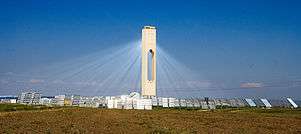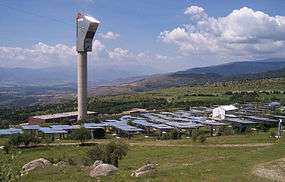Solar power tower
| ||||
Concentrating solar power towers:
| ||||
The solar power tower, also known as 'central tower' power plants or 'heliostat' power plants or power towers, is a type of solar furnace using a tower to receive the focused sunlight. It uses an array of flat, movable mirrors (called heliostats) to focus the sun's rays upon a collector tower (the target). Concentrated solar thermal is seen as one viable solution for renewable, pollution-free energy.
Early designs used these focused rays to heat water, and used the resulting steam to power a turbine. Newer designs using liquid sodium have been demonstrated, and systems using molten salts (40% potassium nitrate, 60% sodium nitrate) as the working fluids are now in operation. These working fluids have high heat capacity, which can be used to store the energy before using it to boil water to drive turbines. These designs also allow power to be generated when the sun is not shining.
Cost
The US National Renewable Energy Laboratory (NREL) has estimated that by 2020 electricity could be produced from power towers for 5.47 cents per kWh.[1] Companies such as ESolar (backed by Google.org) are continuing development of cheap, low maintenance, mass producible heliostat components that will reduce costs in the near future.[2] ESolar's design uses large numbers of small mirrors (1.14 m²), which reduce costs for installing mounting systems such as concrete, steel, drilling, and cranes.
Improvements in working fluid systems, such as moving from current two tank (hot/cold) designs to single tank thermocline systems with quartzite thermal fillers and oxygen blankets will improve material efficiency and reduce costs further.
Design

- Some Concentrating Solar Power Towers are air-cooled instead of water-cooled, to avoid using limited desert water[3]
- Flat glass is used instead of the more expensive curved glass[3]
- Thermal storage to store the heat in molten salt containers to continue producing electricity while the sun is not shining
- Steam is heated to 500 °C to drive turbines that are coupled to generators which produce electricity
- Control systems to supervise and control all the plant activity including the heliostat array positions, alarms, other data acquisition and communication.
Generally, installations use from 150 hectares (1,500,000 m2) to 320 hectares (3,200,000 m2).
Environmental concerns
There is evidence that such large area solar concentrating installations can kill birds that fly over them. Near the center of the array temperatures can reach 550 oC which, with the solar flux itself, is enough to incinerate birds while further away feathers are scorched leading to the eventual death of the bird. Workers at the Ivanpah solar power plant call these birds “streamers,” as they ignite in midair and plummet to the ground trailing smoke. Federal wildlife investigators said there was, on average, one streamer every two minutes. The large array of mirrors from a distance also looks like a lake which naturally attracts birds. There is no obvious solution to this problem.
The Ivanpah Solar Power Facility is classified as a greenhouse gas emitter by the State of California because it has to burn fossil fuel for several hours each morning so that it can quickly reach its operating temperature.[4]
Commercial applications
Recently, there has been a renewed interest in solar tower power technology, as is evident from the fact that there are several companies involved in planning, designing and building utility size power plants. This is an important step towards the ultimate goal of developing commercially viable plants. There are numerous examples of case studies of applying innovative solutions to solar power.[5]
Examples of heliostat power plants
| Power plants | Installed capacity (MW) | Yearly production (GWh) | Country | Developer/Owner | Completed |
|---|---|---|---|---|---|
| Ivanpah Solar Power Facility | 392 (U/C) | 650 | United States | BrightSource Energy | 2013 |
| Crescent Dunes Solar Energy Project | 110 (U/C) | 500 | United States | SolarReserve | 2015 |
| PS20 solar power tower | 20[6] | 44 | Spain | Abengoa | 2009 |
| Gemasolar[7] | 17 | 100 | Spain | Sener | 2011 |
| PS10 solar power tower | 11[8] | 24 | Spain | Abengoa | 2006 |
| Sierra SunTower | 5[9] | United States | eSolar | 2009 | |
| Jülich Solar Tower | 1.5[10][11] | Germany | 2008 | ||
| Greenway CSP Mersin Solar Tower Plant | 5[12] | Turkey | Greenway CSP | 2013 |
Novel applications

The Pit Power Tower[13][14] combines a Solar Power Tower and an Aero-electric Power Tower[15] in a decommissioned open pit mine. Traditional Solar Power Towers are constrained in size by the height of the tower and closer heliostats blocking the line of sight of outer heliostats to the receiver. The use of the pit mine's "stadium seating" helps overcome the blocking constraint.
As Solar Power Towers commonly use steam to drive the turbines, and water tends to be scarce in regions with high solar energy, another advantage of open pits is that they tend to collect water, having been dug below the water table. The Pit Power Tower uses low heat steam to drive the pneumatic tubes in a co-generation system. A third benefit of re-purposing a pit mine for this kind of project is the possibility of reusing mine infrastructure such as roads, buildings and electricity.
See also
- Concentrated solar power
- Feed-in tariff
- List of concentrating solar thermal power companies
- List of solar thermal power stations
- National Solar Thermal Test Facility (NSTTF)
- Solar furnace
- Solar thermal energy
References
- ↑ Assessment of Parabolic Trough and Power Tower Solar Technology Cost and Performance Forecasts
- ↑ Google's Goal: Renewable Energy Cheaper than Coal November 27, 2007
- 1 2 http://www.brightsourceenergy.com/technology/faqs/
- ↑ Danelski, David (21 October 2015). "It's not easy being green: Ivanpah solar plant near Nevada burns much natural gas, making it a greenhouse gas emitter under state law.". Orange County Register. Santa Ana, California. Retrieved 14 September 2016.
- ↑ SOLAR POWER IN THE NEWS
- ↑ Abengoa Solar Begins Operation of World's Largest Solar Power Tower Plant
- ↑ Torresol Energy commissions Gemasolar Power Plant in Spain
- ↑ First EU Commercial Concentrating Solar Power Tower Opens in Spain
- ↑ eSolar Ushers in New Era of Solar Energy with Unveiling of Sierra Power Plant
- ↑ RenewableEnergyWorld: Salt-Free Solar: CSP Tower Using Air
- ↑ DLR: Jülich solar tower power plant – research facility officially handed over to the operator
- ↑
- ↑ Pit Power Tower - Alternative Energy News Feb 2009
- ↑ Pit Power Tower US Patent
- ↑ Energy tower
External links
- Cleantech Group picks winners and losers in concentrated solar thermal
- 'CSP' posts in Green Tech
- eSolar's demonstration plant in Lancaster, Calif.
- National Solar Thermal Test Facility
- Detailed Description of Central Receiver Systems
- Power Station Harnesses Sun's Rays BBC article about solar plant near Seville in Spain
- Description of first commercial Solar Power Tower
- vICERP A research cooperation with a demonstration plant in Juelich, Germany
- Solar Tower Plant Juelich Germany's first solar tower power plant in Juelich
- Heliostat fields on Google maps List of solar tower plants and solar furnaces with heliostat field on Google maps
- Zero Carbon Australia Stationery Energy Plan
Institutional links
- CSIRO > Divisions > CSIRO Energy Technology
- ESTELA > Technology > Tower Technology
- Promes Laboratory > Facilities > Solar concentrators > Themis
- PSA > Facilities > Central Receiver
- Sandia National Laboratory > National Solar Thermal Test Facility > Central Receiver Test Facility > Heliostats and tower capabilities
- Weizmann Institute > Environmental Sciences & Energy Research > Research > Energy Research
Commercial links
- Abengoa Solar > Technologies > Concentrating Solar Power > Power Tower
- Aora-Solar
- BrightSource Energy > Technology > How LPT Works
- Desertec > Concept > Technologies
- Device Logic
- eSolar > Heliostat solutions
- Kraftanlagen München > Field of activities > Renewable energies > Solar thermal power plants > Jülich experimental power plant
- Nur Energie > Projects > Tunisia
- SENER > Projects > Gemasolar
- Solar Reserve > Technology
- Torresol Energy > Technologies > Own technologies > Central-tower technology
- Experimental Solar Thermal Power Plant Jülich (Kraftanlagen München) – YouTube
- Greenway CSP

.jpg)


